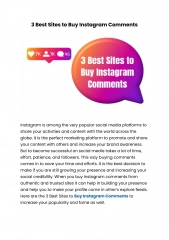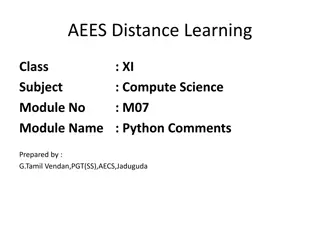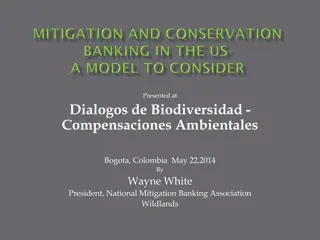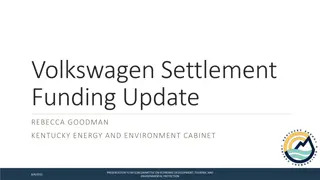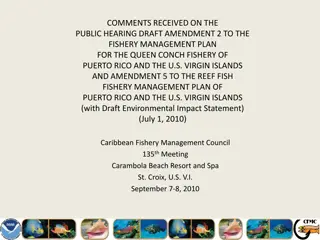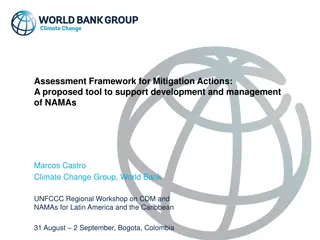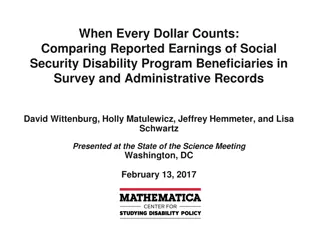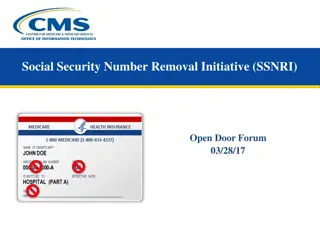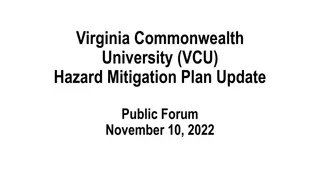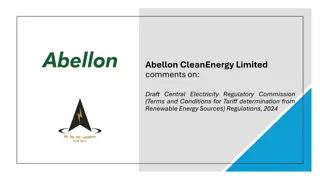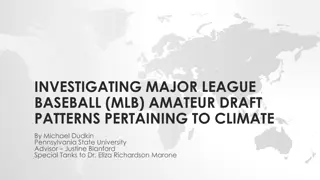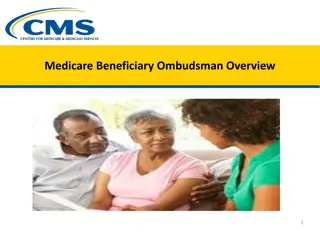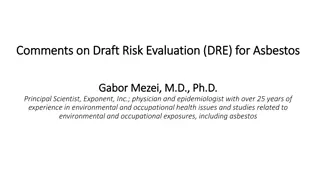Facilitating Questions and Comments for Beneficiary Mitigation Plan Draft
This draft outlines guided questions in three categories related to the Beneficiary Mitigation Plan, focusing on process, eligible mitigation actions, and public policy. It also addresses concerns about the integration of public input, establishment of an advisory board, program design, and effective administration. Audience questions and feedback are encouraged throughout the process.
Download Presentation

Please find below an Image/Link to download the presentation.
The content on the website is provided AS IS for your information and personal use only. It may not be sold, licensed, or shared on other websites without obtaining consent from the author.If you encounter any issues during the download, it is possible that the publisher has removed the file from their server.
You are allowed to download the files provided on this website for personal or commercial use, subject to the condition that they are used lawfully. All files are the property of their respective owners.
The content on the website is provided AS IS for your information and personal use only. It may not be sold, licensed, or shared on other websites without obtaining consent from the author.
E N D
Presentation Transcript
Facilitating Questions and Comments IL DRAFT VW BENEFICIARY MITIGATION PLAN
A. Guided Questions in 3 categories 1. Process Questions Edith Makra, Metropolitan Mayors Caucus 2. Eligible Mitigation Actions and Emissions Calculation Questions Tony Lindsay, Chicago Area Clean Cities Coalition and Gas Technology Institute 3. Public Policy Questions Tim Milburn, Metropolitan Mayors Caucus and Green Ways 2Go Audience Questions follow each category B. Open Audience Questions
Process - Preface The public comment period ends, and surveys are due by April 13, 2018, yet the proposed timeline from IEPA indicates their plan is to submit the final BMP to Trustee only 3 weeks later in early May. This seems like a short time frame to integrate feedback. The allocations of the funds and the process details seem like decisions that should involve a broad range of informed stakeholders.
Process public input How will public input be incorporated? Will draft EMA allocations be reconsidered? Will there be more public hearings and subject matter expert inputs?
Will IEPA Establish an Advisory Board to: Design and oversee application process? Guide project selection? Guide process to document benefits? Guide other design and performance of other elements of the program?
Incentive/ grant program design How will funds be distributed? Grant application and selection? Reimbursement of expenditures? Rebate based on incremental cost? Rebate based on % of total investment? Vouchers payable at time of purchase?
What will be done by to insure this program will run more effectively administered than the current IEPA Clean Diesel and Green Fleet programs?
EMA and Emissions Calculations - Preface NOx reduction is a function of: 1) engine horsepower 2) operating hours 3) duty cycle 4) amount of fuel consumed 5) age of the engine being displaced/remanned 6) type of engine, fuel, and after-treatment being employed in the solution and 7) different baseline emission standards (e.g. Tier 0 vs. Tier 4, locomotive vs. truck). Methodologies for determining the environmental benefits of the various EMAs should be clearly explained and shared with stakeholders.
EMA and Emissions Calculations - Questions What were the comparative duty cycles of the engines considered in the 3 EMA allocations? Example - 100 tons of NOx reduction for on-road trucks and buses appears too small considering alternative fuels such as natural gas near-zero NOx engines vs current diesel engine NOx emissions performance Has natural gas been considered instead of diesel for the locomotives? Example natural gas may reduce NOx better plus reduces GHGs, PM
EMA and Emissions Calculations - Questions How were the population of engines in each of the categories considered? If using diesel, how much more funding becomes available from the Direct Emissions Reduction Act (DERA)?
EMA and Emissions Calculations - Questions How were the Engine Type Potential Emissions Reductions quantified in order to give such high priority to Locomotives? Do this on a total NOx reduction potential basis and not only on an engine size basis? What assumptions went into the off-road emissions per dollar factor used?
EMA and Emissions Calculations - Questions How has IEPA considered the well-to-wheel/cradle- to-grave emissions of NOx in EMAs? Example - power plant NOx emissions in an all-electric school buses?
EMA and Emissions Calculations - Questions Will priority be given to switch to cleaner alternative fuels vs. replacing diesel with more diesel? How have the other criteria pollutants and green house gases been considered? Example - locomotives, the NOx may be reduced, but other applied uses (natural gas, electrification) may have comparable NOx reductions and have significant reductions in other criteria pollutants and, in particular, GHGs (CO2)
EMA and Emissions Calculations - Questions Why are school buses are singled out for funding, but lowest ranked for emissions reductions? Wouldn t additional on-road class 4-8 trucks and buses be a better choice?
EMA and Emissions Calculations - Questions Why is 10% allocated for electric bus fleets? Why not let bus fleet managers decide how to reduce NOx? Example - the cost of electric buses is much higher than conversion to propane or natural gas. A higher number of alternative fuel fleet buses could be put on the road for the same allocated funding and perhaps with less NOx.
EMA and Emissions Calculations - Questions What about Biodiesel and Ethanol? How will the IL BMP adapt for innovation, and changes technology and state policies?
Other EMA and Emissions Calculations Questions?
Public Policy- Preface Non-road" (ostensibly a railroad/locomotive focus) have a stated substantial allocation (65%) in the IL BMP. This is in contrast to 20% for on road and 10% for electric buses. The rationale behind these splits is unclear and requires greater transparency, when considering the needs of municipalities, especially environmental justice (EJ) communities and other Illinois shareholders. The use of the funds for public benefit should follow a clearly stated and justified charter in order to gain the best outcomes.
Public Policy- Comment Rail can and will have access to US DOT/CMAQ and DERA funding. Public and private fleets must rely on state existing & proposed grants & incentives. Manage DERA and Green Fleets programs more effectively.
Public Fleet Demonstration Value & Immediate Benefits Investing in greener public fleets demonstrates sustainability and new technology. It can help gain broad public acceptance. Benefits are more apparent to the public and extend beyond immediate NOx reduction. Rail investments miss this opportunity. Has this been considered? What about an explicit public sector carve-out?
Public Policy- EV charging infrastructure Appendix D, EMA 9 calls out up to 15% for EV charging infrastructure. This is not clear in the IL EPA BMP. Will there be specific definitions for EV charging infrastructure in the final BMP?
Public fleets Class 1-3 trucks Smaller vehicles are not now eligible in IL BMP or the Consent Decree (App D). IEPA has discretion over the allocations and may have the authority to include the smaller vehicles. Can this be considered? Example - encourage alternate fuel use in Class 4-6 vehicles, to stimulate increased fueling infrastructure investments that would benefit Class 1 through 8 vehicles.
Municipal fleets & Environmental Justice (EJ) Municipal fleets are used within community borders Emissions directly impact targeted EJ populations. Clearly address IEPA s objectives Can aging public fleets in EJ communities be prioritized? What about a carve-out?
Open Questions on IL BMP Please use a microphone State your name and agency Ask your question
Thank you for your participation Please provide written comments by April 13 Take the online survey http://www.epa.illinois.gov/topics/air- quality/vw-settlement/index
Thank you to our partners Argonne Nation Laboratory Illinois EPA Bureau of Air Chicago Area Clean Cities Coalition Municipal Fleet Managers Association Member Councils of Governments, especially Northwest Municipal Conference DuPage Mayors and Managers Conference Metro West Council of Governments Lake County Municipal League
Thank you to host Moraine Valley Community College Green Ways 2Go


